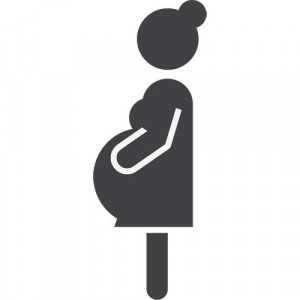Back Pain in Pregnancy is Very Common
 It is estimated that between 50% and 80% of women experience some form of back pain during pregnancy. Such pain can range from mild pain associated with specific activities to acute back pain that can become chronic back pain. Studies show that lower back pain in pregnancy usually occurs between the fifth and seventh month of being pregnant. In some cases, pain in the lower back can begin as early as 8 to 12 weeks after becoming pregnant. Women with pre-existing lower back problems are at higher risk for back pain, and their back pain can occur earlier.
It is estimated that between 50% and 80% of women experience some form of back pain during pregnancy. Such pain can range from mild pain associated with specific activities to acute back pain that can become chronic back pain. Studies show that lower back pain in pregnancy usually occurs between the fifth and seventh month of being pregnant. In some cases, pain in the lower back can begin as early as 8 to 12 weeks after becoming pregnant. Women with pre-existing lower back problems are at higher risk for back pain, and their back pain can occur earlier.
Related Articles:
There are Two Common Types of Back Pain in Pregnancy: Lumbar, or Lower Back Pain and Posterior Pelvic Pain.
It is useful to know the difference between the above two types of back pain in pregnancy and labor pain, which is also felt in the back during pregnancy.
1 – Lower Back Pain (Lumbar Pain)
 Lumbar pain during pregnancy is generally located at and above the waist in the center of the back. This lower back pain may or may not be concurrent with pain that radiates into your leg or foot. Pain that radiates into the leg or foot is known as sciatica and you can read more about that under the “lumbar radiculopathy section”. In general, lumbar pain during pregnancy is similar to lower back pain experienced by non-pregnant women. This type of pain typically increases with prolonged postures such as sitting or standing. Tenderness may also be present in the muscles along the spine (the paraspinal muscles).
Lumbar pain during pregnancy is generally located at and above the waist in the center of the back. This lower back pain may or may not be concurrent with pain that radiates into your leg or foot. Pain that radiates into the leg or foot is known as sciatica and you can read more about that under the “lumbar radiculopathy section”. In general, lumbar pain during pregnancy is similar to lower back pain experienced by non-pregnant women. This type of pain typically increases with prolonged postures such as sitting or standing. Tenderness may also be present in the muscles along the spine (the paraspinal muscles).
2 – Pregnancy Pelvic Pain
Posterior pelvic pain (in the back of the pelvis) is four times more prevalent than lumbar pain in pregnancy. It is a deep pain felt below and to the side at the waistline, and/or below the waistline on either side across the tailbone. Such pelvic pain may be experienced on one or both sides. Posterior pelvic pain during pregnancy can be brought on or exacerbated by the following activities: Rolling in bed, Climbing stairs, Sitting and rising from a seated position, lifting, twisting, bending forward, running and walking. If a woman has a job that involves prolonged postures at extreme ranges that increases the risk of developing pregnancy pelvic pain.
Unlike many other forms of lower back pain in pregnancy, a previous high level of fitness does not necessarily prevent posterior pelvic pain while pregnant.
** It is important to differentiate this pain from labor pain **
Labor pain is persistent, it increases in intensity and frequency over a short period of time. It is not affected by your level of activity.
Causes:
Both pregnancy pelvic pain and lower back pain may be caused by several factors related to bodily changes that naturally occur while pregnant.
Common changes that can cause back pain include:
- Weight gain
- Center of gravity changes (with the weight now typically carried in the front)
- Muscular imbalances
- .. and hormonal surges (relaxin and estrogen) which can cause problems by creating joint laxity, especially in the pelvis.
Treatment:
Conservative (non-surgical) treatment generally includes performance of appropriate exercise and use of proper body mechanics. Often just a few visits to a specialist will be enough. These treatments include:
- Stabilization Exercises;
- Proper posture;
- Appropriate body mechanics for routine activities, such as housework, job activities, and while sleeping;
- A home exercise program appropriate for your stage of pregnancy; and,
- Hands-on treatment (such as soft tissue work, gentle mobilization, and stabilization exercises) as determined to be safe by a healthcare professional.
References:
- http://americanpregnancy.org/pregnancy-health/back-pain-during-pregnancy/
- Katonis, P., Kampouroglou, A., Aggelopoulos, A., Kakavelakis, K., Lykoudis, S., Makrigiannakis, A., & Alpantaki, K. (2011). Pregnancy-related low back pain. Hippokratia, 15(3), 205–210.
- Gutke A, Ostgaard HC, Oberg B. J Rehabil Med. 2008 Apr; 40(4):304-11.
- Bastiaanssen JM, de Bie RA, Bastiaenen CH, Essed GG, van den Brandt PA. Eur J Obstet Gynecol Reprod Biol. 2005 May 1; 120(1):3-14.

